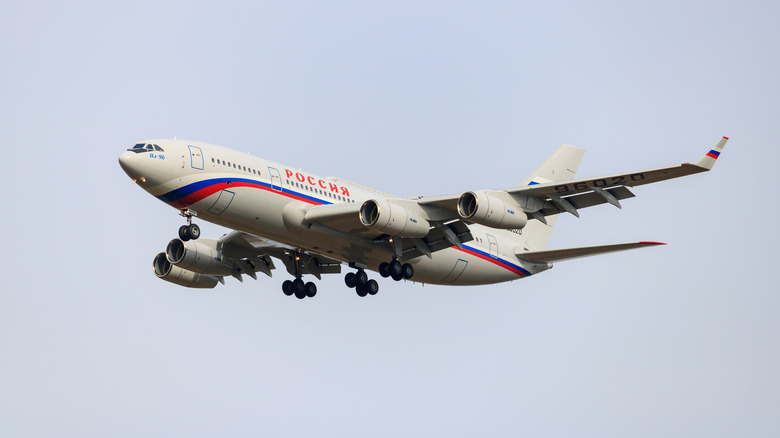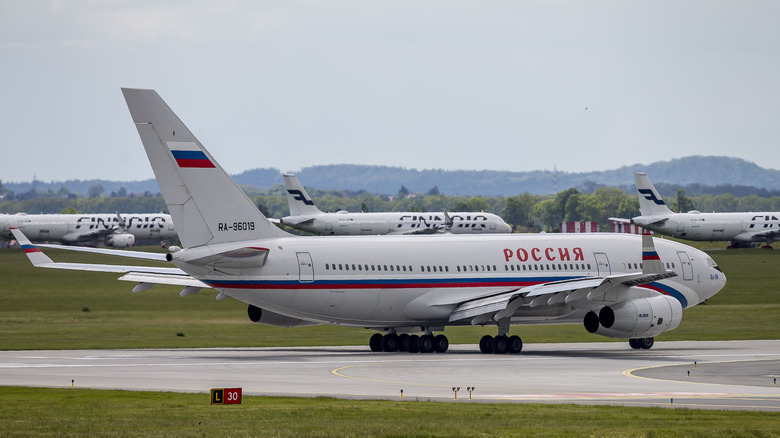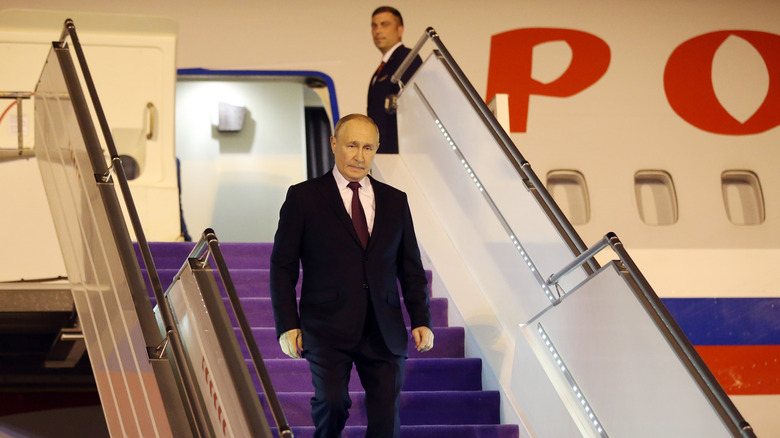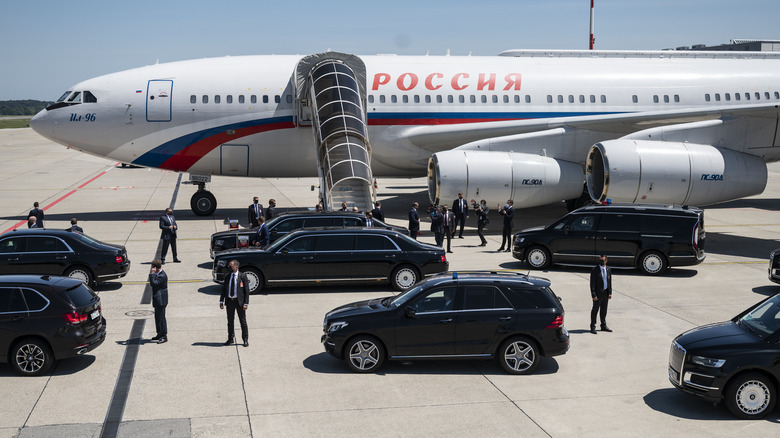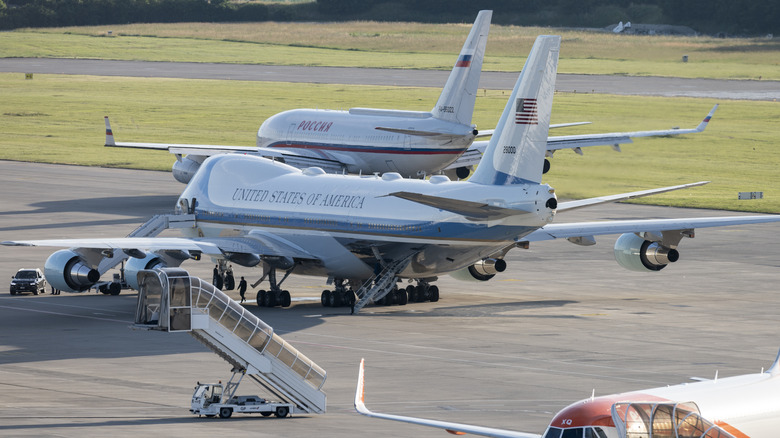All You Need To Know About The Russian Air Force One
Whenever the President of the United States travels abroad representing the nation, he steps down from the red-carpeted ladder of the Boeing VC-25, popularly known as Air Force One. It's not just a secure transport for the most powerful person in the country but also a symbol of the nation's political might. The larger, grander, and more impressive the jet, the better the image. Superpowers like the U.S. make use of the iconic Boeing 747 jumbo jet. China, while currently lacking a dedicated VIP plane, regularly charters Boeing 747-8s from Air China to ferry its leader around the world. As for Russia, the President travels in style internationally.
Officially known as the Ilyushin Il-96-300PU, the jet has a desginated call sign of "Plane No.1" when the President is aboard. The aircraft features conference rooms, executive suites, and other facilities that perfectly mimic a flying state residence. The "PU" suffix in its name stands for "Punkt Upravleniya" ("Command Post"), which perfectly describes the aircraft's secondary mission: serving as an airborne command post from which the Russian head of state can direct operations, including controlling the country's nuclear forces, if necessary.
For the jet to fulfill these roles, it had to undergo extensive modifications. While the full capabilities of the Il-96-300PU remain classified, there are still a few fascinating details about this jet that are publicly known.
The Problematic Il-96
Reading into the Ilyushin Il-96, you might actually wonder why the Russian government decided to pick it as the main transport for their leader. On paper, it seems to have everything a VIP transport needs: four engines for redundancy, and a wide-body fuselage offering ample space for the President and staff.
However, beyond its overall design, the Il-96 doesn't have much else going for it. The plane is an evolution of the Il-86, which had a disappointing service record throughout its limited operation. The Il-96 was envisioned as a turnaround point for Ilyushin's commercial airliners, but ultimately failed to live up to expectations. The "improved" Il-96 received a lackluster reception upon its announcement, and today, apart from a handful of airlines, the type is almost exclusively operated by the Russian military.
The aircraft has been plagued by technical issues throughout its service life, even today. Infamously, the braking system of the Il-96-300PU — arguably one of the best-maintained aircraft in the Russian air fleet — failed during Putin's visit to Finland in 2005, and he was forced to return on a backup plane. The only reason the Il-96 made the shortlist was pure national pride. While not the best, it's still a Russian-made product. It'd reflect poorly on the leader of a nation with a developed aerospace industry to fly around on a European or American plane!
What Matters is on the Inside
The Il-96-300PU is operated by the Special Flight Detachment (SLO) "Rossiya," which was once a part of Russia's largest air carrier, Rossiya Airlines, and thus bears its livery. The detachment was transferred to the Russian government in 2009, but the livery remains: the word "Россия" (Russia) is emblazoned in red along the fuselage, with a Russian flag painted on the vertical stabilizer. That's where the similarities between the Il-96-300PU and the rest of Rossiya Airlines' fleet end, though.
While we don't have the full floor plan, the plane is known to have a private office for the president, an executive suite with a king-size bed, secure conferencing and meeting rooms, a clinic, dining rooms, lounges, bars, and even a gym. All the rooms are opulently decorated in cream tones with golden trimmings, featuring handcrafted embroidered paneling designed to reflect Russian folk cultures.
Apart from the lavish interior and amenities offered to its passengers, little else is known about the jet. However, it's widely believed that the aircraft is equipped with cutting-edge communication systems, allowing the Russian president to stay connected with all branches of the government and military. The jet can also function as a command post, granting the president the ability to rapidly put the country's nuclear forces on high alert. Furthermore, the jet is almost certainly outfitted with an array of advanced self-defense measures, such as chaff-and-flare dispensers and electronic countermeasures to thwart potential threats from the air or ground.
There's More Than a Single Plane No.1
Because they all look the same, it's very easy to think that the Russian president only flies on a single plane. That actually isn't the case: the SLO "Rossiya" operates up to five identical Il-96-300PUs, with the newest one constructed and delivered in 2021, reportedly featuring upgraded avionics. For security reasons, all jets that fly the president must be under 15 years old and once an aircraft passes this milestone, it's "handed down" to transport lower-level VIPs, not the president. The Il-96-300PUs are regularly swapped between trips, too, to ensure each aircraft receives sufficient maintenance time to perform its best.
Whenever the president travels, a reserve aircraft carrying non-essential staffers and journalists follows "Aircraft No.1." If the main jet encounters problems, any of the shadowing jets can pick up its important passengers and continue the trip — a scenario President Putin experienced firsthand during the Finland brake burnout incident in 2005.
There's also a third "forward plane" that carries technicians and security personnel which, if the main plane develops issues, would immediately work on making it flyable again. All these technicians are specially authorized to work on the jet because, as a rule, no one — especially foreigners — is allowed to work on the Il-96-300PU or any other VIP transport.
How Does it Fare Against the Air Force One?
Now, here's the question: is the Il-96-300PU as good as America's vaunted Air Force One? The short and objective answer is no.
Not only is the Il-96-300PU smaller (approximately 181 feet long versus the VC-25's 231 feet), but it's also far less powerful. The four Aviadvigatel PS-90 turbofans on the Il-96-300PU generate about 35,300 pounds of thrust each, giving the aircraft a maximum takeoff weight (MTOW) of around 270 tons. In contrast, each of the massive General Electric CF6-80C2B1 turbofans on the VC-25 can generate double the thrust at 56,700 pounds, allowing the VC-25 can lift more weight with less power. The American president can bring along more people and supplies as a result, plus it gives the U.S. Air Force plenty of headroom to pack vital secure equipment into the aircraft.
The VC-25 also has an edge in range due to an aerial refueling receptacle in its nose. As long as it's regularly refueled by a tanker aircraft, the jet can (at least theoretically) fly forever. The Il-96-300PU doesn't have this capability.
Last but not least, the Il-96-300PU definitely can't match the VC-25 in terms of comfort. The galley on the Russian jet can only serve pre-packed meals (which Putin has gone on record complaining about before). On the other hand, American presidents are always treated to special menu items on the VC-25, made hot and fresh by chefs in the kitchen at the back.
